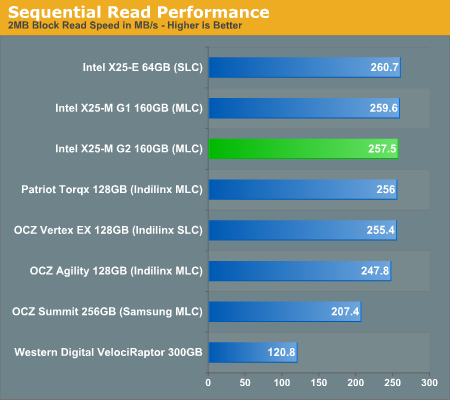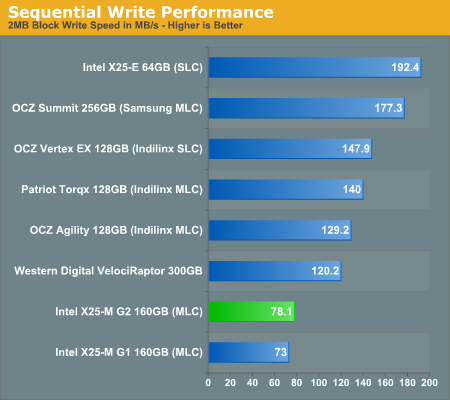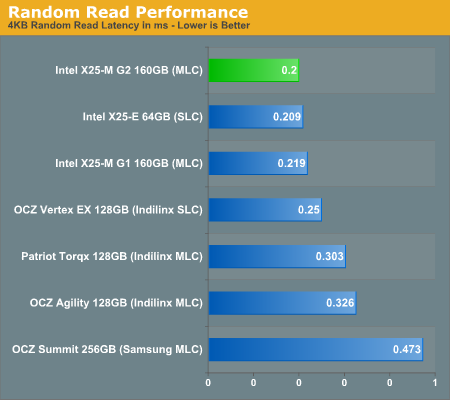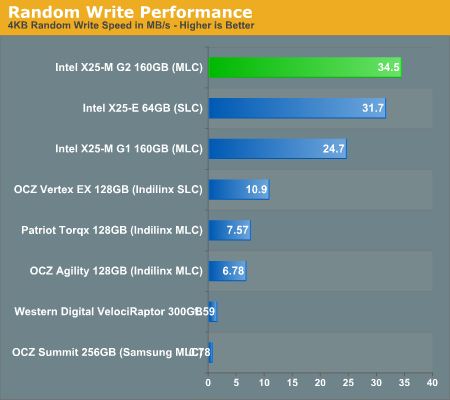Intel X25-M G2: Dissected and Performance Preview
by Anand Lal Shimpi on July 22, 2009 6:00 PM EST- Posted in
- Storage
The Performance
There are four basic pillars to SSD performance that I like to look at: random read, random write, sequential read and sequential write speed. A good SSD must be strong in all four categories, but some are more noticeable than others. Random read and write speed, particularly of small files (e.g. 4KB) are normally what make our desktop hard drives feel so slow. These random operations are everything from file and table updates to search queries and loading applications; they aren't random over the entire space of the disk but they are random enough to bring conventional hard drives to their knees.
Sequential read/write speed is what you encounter when copying large files. How quickly you can move a Blu-ray image around is determined by these values. I've run all four tests on these drives using IOMeter. I also test all SSDs in a completely used scenario where each LBA/page has been touched, at some point, with valid data. Brand new, out of the box, performance will be greater but not over the life of the drive. If you want to know more about why this is and how I test, I suggest consulting The SSD Anthology.

Sequential read performance is basically maxed out for these drives; we're bottlenecked by the SATA bus at this point (300MB/s minus some overhead). We won't see sequential read performance improve until the 6Gbps SATA protocol starts appearing in controllers. The X25-M G2 is basically the same speed as the previous gen here.

Sequential write performance has always been a bottleneck on the Intel drives. There's a small 7% performance improvement from the new drive, but it's still much slower than any other MLC drive in its class. Pushing higher speeds isn't an issue for the controller as the SLC X25-E actually posts our fastest numbers here.
While I don't believe that 70MB/s write speeds are terrible, Intel does need to think about improving performance here because the competition is already far better. The more important values are still random read/write performance, but sequential write speed is an area that Intel continues to lag behind in.

The real strength of the Intel drives is in its random, small file, read/write performance. Here we see a 10% improvement in random read performance over the 1st gen drives, putting the new X25-M ahead of even the X25-E. Now there are obvious lifespan benefits you get from an SLC drive that the G2 can't match, but for a desktop user this thing is even better than the X25-E.
None of the competitors can touch the X25-M here; Intel is 50% faster than the closest MLC contender. It's tough to read but the WD VelociRaptor scores a 0.68MB/s score here.

These are the same results as above but I'm reporting average latency instead of average transfer rate. It gives you a bit of the idea of the scale of performance here. I had to remove the WD VelociRaptor because its read latency threw the chart's scale off, it averaged 17.3 ms here.

And the X25-M G2's true strength: random write performance. Once again, we're faster than the X25-E and nearly 40% faster than the X25-M G1. None of the Indilinx or Samsung drives can touch Intel here.
The Samsung RBB controller does not seem to like worst-case random writes on a well used drive, it's actually slower than the VelociRaptor here. This is what I've seen in my earlier investigations as well. It actually helps explain why the older Samsung based SSDs in Apple notebooks never really felt all that fast.
Final Words...for now
The X25-M G2 appears to be everything Intel said it would be. It's anywhere from 0 - 40% faster than the 1st gen drive in these low level tests. I would expect to see a 0 - 10% improvement in the real world depending on applications, but that's what I'm off to test next.










87 Comments
View All Comments
has407 - Sunday, July 26, 2009 - link
Seen the same on a couple sites. Apparently setting a drive password and then trying to change or disable it can cause the drive to become inaccessible. They're also no longer listed on Newegg.Jefrach - Monday, July 27, 2009 - link
I bought one of these drives from Newegg the day they were released. I just received an email today saying I was getting a refund because they were out of stock and that the item is discontinued. Price was at listed 449.billybob54321 - Saturday, July 25, 2009 - link
Anand-I know application performance is on its way, but I'd love to see individual perforamnce time of actually running applications. The original Intel SSD review focused on copy/launch times whereas I'd be interested in run times of apps after they are launched.
http://www.anandtech.com/storage/showdoc.aspx?i=34...">http://www.anandtech.com/storage/showdoc.aspx?i=34...
For example, I do a lot of work in Photoshop CS4 with big RAW files. It's unclear whether the random read/write speed of the Intel drive would be superior to the sequential write of the Vertex drive when working in PS CS4 because the temp files can get into the 100's of megabytes.
Thanks for your hard work!
erikejw - Friday, July 24, 2009 - link
Is this benchmarked in a used state of the drive?That is how we all use hard drives so if it is not it is pretty worthless for users.
Cov - Friday, July 24, 2009 - link
Here you can find results of someine who tested his SSD (that he just bought)with CrystalDiskMark:http://hardforum.com/showthread.php?t=1436928&...">http://hardforum.com/showthread.php?t=1436928&...
(last posting on that side)
piasabird - Friday, July 24, 2009 - link
These performance tests do not tell you anything.1. How do they compare when actually running programs in an operating system?
2. How do they compare to a standard 500gig Hard Drive?
How are these to be used? Are people planning on using them as hard drive replacements in laptops? What about Heat and cooling requirements like you might mention for RAM or a video card?
The reason I am asking these questions is Microsoft Windows as an operating system is not designed that well to use these devices, and they dont show much advantage when used in cooperation with a hard drive to boot a computer faster. This seems like much todo about nothing when I can purchase a 320GB Drive for about $100.00.
evand - Friday, July 24, 2009 - link
Well, some application benchmarks would be nice. But then, the article is titled "performance preview". If you don't know how to read these numbers and take a guess at what it will mean for you, then don't.They compare very, very favorably to a top of the line, high performance hard disk, and you're asking how well they compare to a drive that said high performance disk will eat for breakfast? Seriously, the comparison almost isn't worth making. If you're really curious, find reviews of the disk you want compared to, and see what high performance rotating drives they compared it against (or go see what regular drives that high performance drive was compared against in its reviews).
People are considering using these on laptops, on desktops as a primary (OS / apps / heavily used data) drive with rotating media for bulk storage, in silent /fanless computers, etc.
Why do you even need to ask about cooling and heat sinks? It doesn't need them. It draws 150mW of power. Putting heat sinks on it would be ludicrous.
So what if Windows isn't "designed" to use these disks? It will use them without any problems. Perhaps a more carefully designed OS could eek a bit more out of them, but so what? It should be worlds faster than any rotating media you can compare it to.
If you want capacity, go buy a 1TB drive to use a secondary data drive for $100, and use one of these for things that care about io performance rather than storage. Splitting your data across the two disks to get both good performance and lots of space isn't exactly hard for the normal desktop usage case.
evand - Friday, July 24, 2009 - link
I was discussing these drives with someone who works in the storage industry with Flash technology, but not these specific drives. He had an interesting observation: a lot of flash drives will keep a pool of pre-erased pages available for writing. However, they can't erase new pages fast enough to keep up with the peak random write performance indefinitely. Once the pre-erased pool runs dry, random write performance drops dramatically.Is this the case with the new (or old, for that matter) Intel drives? How long a time period do your random write benchmarks run for? Would you be willing to run a random writes benchmark that runs long enough to overwrite a larger fraction of the disk, and tell us whether the performance drops under sustained load?
iwodo - Friday, July 24, 2009 - link
I just read other review site that Intel SSD uses SUBSTANTIALLY more CPU usage then other competing SSD. I hope your future detail review will test this out as well.Even thought Intel SSD uses much less power then competing SSD, the CPU usage required will discount those saving. ( Possibly uses even more power. )
In could be another case for Intel to push you buying a more powerful CPU. Which is rather sad. Since this is exactly what happen to USB, which makes it slow and unresponsive compare to Firewire.
pmeinl - Friday, July 24, 2009 - link
Does anybody know PC cases optimized for SSDs.I only found the following enclosures to mount SSDs in cases designed for HDs:
http://vr-zone.com/articles/a-data-ssd-enclosure-t...
http://www.patriotmemory.com/products/detailp.jsp?...">http://www.patriotmemory.com/products/d...prodgrou...
http://www.newegg.com/Product/Product.aspx?Item=N8...">http://www.newegg.com/Product/Product.aspx?Item=N8...